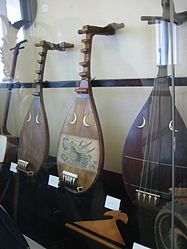Gakubiwa

A selection of biwa in a Japanese museum
|
|
| Classification | |
|---|---|
| Related instruments | |
|
|
The biwa (琵琶) is a Japanese short-necked fretted lute, often used in narrative storytelling. The biwa is the chosen instrument of Benten, goddess of music, eloquence, poetry, and education in Japanese Shinto.
The origin of biwa is Chinese pipa. It arrived in Japan in two forms. Since that time, the number of biwa types has more than quadrupled. Guilds supporting biwa players, particularly the biwa hoshi, helped proliferate biwa musical development for hundreds of years. Biwa hōshi performances overlapped with performances by other biwa players many years before heikyoko and continued until today. This overlap resulted in a rapid evolution of the biwa and its usage and made it one of the most popular instruments in Japan.
Yet, in spite of its popularity, the Onin War and subsequent Warring States Period disrupted biwa teaching and decreased the number of proficient users. With the abolition of Todo in the Meiji period, biwa players lost their patronage.
Furthermore, reforms stemming from the Meiji Restoration led to massive, rapid industrialization and modernization. Japan modeled its development on Europe and the US, praising everything Western and condemning everything native. Traditions identifiably Japanese became associated with terms like backwards or primitive. Such associations even extended into areas like art and music, and the biwa.
By the late 1940s, the biwa, a thoroughly Japanese tradition, was nearly completely abandoned for Western instruments; however, thanks to collaborative efforts by Japanese musicians, interest in the biwa is being revived. Japanese and foreign musicians alike have begun embracing traditional Japanese instruments, particularly the biwa, in their compositions. While blind biwa singers no longer dominate the biwa, many performers continue to use the instrument in traditional and modern ways.
The biwa came to Japan in the 7th century and it was evolved from the Chinese instrument pipa, while the pipa itself was derived from similar instruments in Western Asia. This type of biwa is called the gaku-biwa and was used in gagaku ensembles and is the most commonly known type. While the route is unclear, another type of biwa found its way to the Kyushu region, and this thin biwa (called mōsō-biwa or kōjin-biwa) was used in ceremonies and religious rites. Before long, as the Ritsuryō state collapsed, the court music musicians were faced with the reconstruction and sought asylum in Buddhist temples. There they assumed the role of Buddhist monks and encountered the mōsō-biwa. They incorporated the convenient aspects of mōsō-biwa, its small size and portability, into their large and heavy gaku-biwa, and created the heike-biwa, which, as indicated by its namesake, was used primarily for recitations of The Tale of the Heike.
...
Wikipedia
